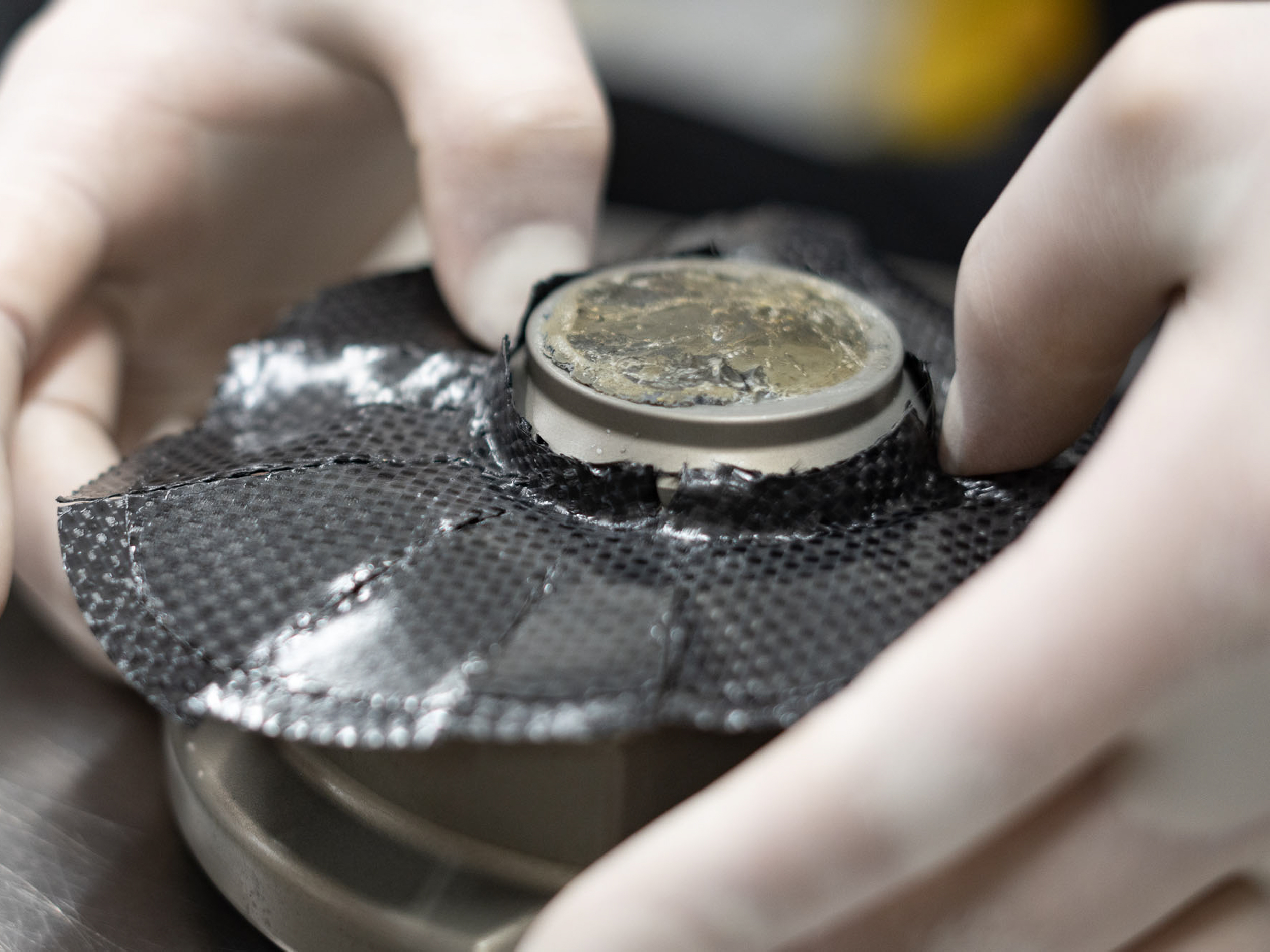But this wasn’t always the case. In the ’80s and ’90s, steel and aluminum ruled the industry. Titanium was for custom frames or bikes at the tip of the spear. Carbon fiber bike frames were getting going, but the material was still unattainable to most.
Prices have changed interestingly in the last 30+ years of bicycle frame development. Carbon fiber, the rarest frame material of the past, is now common. Although still spendy, the prices have come down.
Steel used to be affordable and still can be. But now, custom builders are getting premium pricing for what used to be the most common frame material. Titanium and aluminum seem to have held their relative position in the frame material pricing hierarchy.
This is our breakdown of the hows and whys of carbon fiber bike frames.
How Carbon Fiber Bike Frames Are Made

Filaments and Epoxy Resins
Carbon fiber is an excellent material from which to craft a bicycle frame. The strength-to-weight ratio of carbon bike frames is unbeaten, and brands can “program” other characteristics. Manufacturers can alter fiber size and direction, the weaving pattern, if any, the number of layers, the shape of the pieces, and the bonding agent.
Carbon fiber frames start from what it sounds like; thin filaments 10 to 20 times smaller than a human hair. Carbon fabric suppliers group the filaments to form a “tow,” or ribbon. The number of filaments per tow commonly describes carbon in the cycling industry. “3K” carbon has 3,000 filamaments per tow.
Suppliers combine the carbon fiber tows with a bonding agent, usually a two-part epoxy resin. At this stage, the resin and tow are now a composite material the industry calls carbon fiber-reinforced polymer (CFRP).
The carbon filaments alone are incredibly lightweight. The epoxy resin, by contrast, is heavy. So manufacturers do everything they can to limit the amount of resin and any voids within the composite.
The “recipe” of filaments and resin that carbon fiber producers follow affects the “modulus” of the carbon fiber. This term often appears in marketing materials for carbon fiber bike frames and wheels. Modulus refers to the stiffness of the CFRP.
Although it may seem like more stiffness is better, it also means that the carbon fiber has less strength. So, like many aspects of a bicycle, it’s a compromise. Also, higher modulus carbon fiber is more costly to produce.
The carbon fiber fabric usually ships to frame manufacturers in “prepreg” rolls. The carbon fiber supplier impregnates the fabric with epoxy resin, so the frame manufacturer doesn’t have to do that step. The material is ready to be cut into pieces and laid into molds.
At least one brand applies resin to dry carbon fiber fabric draped over wax forms. Other processes, like carbon fiber bike frame printing, are developing.

Most carbon fiber bicycles and components today utilize epoxy resin as the binding agent. A few smaller companies are employing long-chain polymers as bonding agents. This lends a different flexing characteristic to the final product. And also makes it recyclable, whereas carbon fiber products that use epoxy resin are not.
Molds and Layups

Frame manufacturers create their own “recipes” of carbon fiber pieces, laid into molds of their creation, and “baked” in their specific process. Each of the many variables gives the bicycle frame the lateral stiffness, vertical compliance, impact resistance, and other physical attributes the design team targets.
Workers lay the carbon fiber prepreg fabric flat on tables and cut the hundreds of individual pieces that make up a frame out of it. These pieces are then hand-laid into molds, usually made of metal, in an order and fiber direction specified by the engineers.
Carbon fiber frame brands direct the amount of overlap and the number of layers required to produce the desired attributes. The “instruction manual” for this layup process is the layup schedule, which can vary for each frame size to handle the differing loads.

Brands can use different carbon fiber fabrics for different pieces. This takes advantage of higher and lower modulus carbon fiber to achieve specific goals or cost targets.
The molds generally come in two halves. When both sides’ layups are complete, the workers clamp the halves together, and usually, an internal, inflatable bladder is inside.
Shake and Bake

Skilled workers heat the clamshell molds, carbon layup, and internal bladder to activate the pre-impregnated epoxy resin. During this process, the builder pressurizes the inner bladder to press the carbon against the interior mold walls to reduce voids. These voids can produce weak areas if they are still present when the epoxy resin cures.
Carbon bike frame brands strive to improve layup compaction to eliminate voids and have devised different strategies. Most still use an inflatable bladder. Others use non-inflatable but expanding internal molds made of silicone (which grows with temperature increases). I predict continued advancements in compaction as engineers develop more efficient methods of molding carbon fiber bike frames.
Carbon Bike Frame Post-Mold Processes
Once the frame cures and the builder releases it from the mold and bladder, there is still substantial work to do before it is ready to ship or have parts installed. These post-mold processes, like the layup process, require a hefty portion of the total labor time.
These steps include deflashing, sanding, machining, surface treatments, and final preparations for painting. The post-mold process can account for 50-60% of the total labor time and present an opportunity to cut costs through upfront engineering, according to Composites World.
An example would be to create molds and layup schedules that ensure a more consistent surface finish of the frame. Reducing post-mold labor is an area where American manufacturers can close the price gap to Asian frame production.
The Carbon Fiber Bike Frame Factory Perception

Some negative perceptions have sprouted as carbon fiber frames have become more common, less expensive, and mainly produced off-shore. Cyclists can say they are “soul-less.” Visions of giant, smoke-spewing factories replace the idyllic thought of a fabricator patiently brazing a frame in a small shop.
But human labor is almost entirely responsible for carbon fiber bike frame production. It’s primarily hands-on, from cutting the carbon fabric into pieces to laying them in the molds to finishing and painting them afterward.
I was guilty of harboring this “factory carbon” perception until I witnessed carbon fiber bike frame production at ENVE Composites. It is truly a human labor-intensive process. And although fancy terms like “computational fluid dynamics” saturate marketing materials, ultimately, the final calls on design and engineering titrate down to a human making decisions. Much of it is based on riding experiences. No, it isn’t a human with a brazing torch in a shed referencing tube lengths and angles on paper. But it’s a far cry from the assembly line vision many have.
“What most people don’t understand about carbon frames is that it’s not specifically the material itself that drives the cost of a carbon frame up. It is the labor involved to turn the carbon into a usable product. Very little of the carbon manufacturing process is automated.
“Typically, the difference between a $3000 carbon frame and a $5000 frame isn’t the modulus or quality of the fiber; rather, it’s the amount of time and energy put into refining every component of the layup and the amount of time it takes to place each of those components in the molds,” says Jake Pantone, VP of Product and Brand at ENVE Composites.
Carbon Fiber Bike Frame: The Most Customizable

Now you understand the basics of carbon fiber bike frame manufacturing. I hope you get a feel for how remarkable the material is. Carbon bike frame brands can determine almost every characteristic through specific carbon fabrics, bonding agents, layup schedules, mold shaping, and compaction processes. Carbon fiber is genuinely the most customizable material for bicycle frame production.
Frame builders must work with the available tube shapes for titanium, steel, and aluminum, severely limiting design options. There have been recent advancements in additive manufacturing, like printed titanium. But these exciting technologies are far from becoming as common as carbon fiber bike frames.
But innovation drives the cycling industry, much of it through the crucible of professional racing. At the upper echelons of the sport, well-funded teams delve into every marginal gain imaginable. And not too long ago, substituting carbon fiber for steel or aluminum was “marginal.” And through additional material and manufacturing development, the price of carbon fiber bikes and components will hopefully continue to fall.
Carbon fiber bike frames are still not crash-worthy compared to steel, aluminum, or titanium. But repairing them is much more probable these days, with a handful of U.S. facilities handling frame repairs in a timely and affordable manner. This was a vast improvement from a few decades ago when the few carbon fiber frame builders were the only options.








